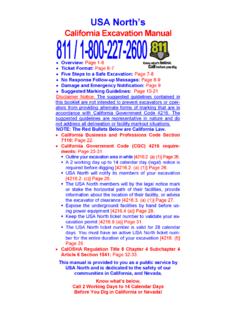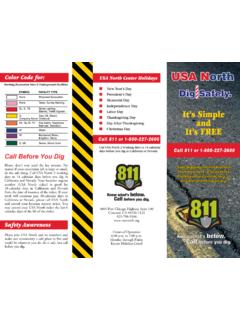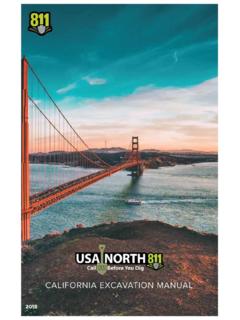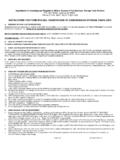Transcription of USA North’s
1 USA north s California excavation manual Overview: Page 1-6. Ticket Format: Page 6-7. Five Steps to a Safe Excavation: Page 7-8. No Response Follow-up Messages: Page 8-9 Damage and Emergency Notification: Page 9 Suggested Marking Guidelines: Page 10-21. Disclaimer Notice: The suggested guidelines contained in this booklet are not intended to prevent excavators or opera-tors from providing alternate forms of marking that are in accordance with California Government Code 4216. The suggested guidelines are representative in nature and do not address all delineation or facility markout situations. NOTE: The Following Two Bullets are California Law. California Business and Professions Code Section 7110: Page 21. California Government Code (CGC) 4216 require-ments: Page 22-30. Outline your excavation area in white [ (a)] Page 25.
2 A 2 working day up to 14 calendar day (legal) notice is required before digging [ (a)] Page 25. USA north will notify its members of your excavation [ (c)] Page 25. The USA north members will by the legal notice mark or stake the horizontal path of their facilities, provide in-formation about the location of their facility, or advise of clearance [ (a)] Page 26. Expose the underground facilities by hand before using power equipment [ (a)] Page 27. The USA north ticket number is valid for 28 calendar days. You must have an active USA north ticket num-ber for the entire duration of your excavation [ (c)] Page 25. Keep the USA north ticket number to validate your ex-cavation permit [ (a)] Page 30. CalOSHA Regulation Title 8 Chapter 4 Subchapter 4 Article 6 Section 1541: Page 30-32 This manual is provided to you as a public service by USA north and is dedicated to the safety of our communities in California, and Nevada.
3 Know what s below. Call 2 Working Days To 14 Calendar Days Before You Dig in California or Nevada! 1 OVERVIEW USA north provides a free and effective Damage Preven-tion Service that protects our citizens, our communities, our environment, our essential public services, and our under-ground facilities in Central / Northern California and all of Nevada. USA north began operation in May of 1975 and incorporated as a Non Profit Mutual Benefit Corporation in 1986. Our purpose is to receive planned excavation reports that will begin within the next 14 calendar days from home-owners, excavators, or professional contractors and trans-mit those planned excavation reports to all participating members of USA north who may have facilities at that ex-cavation site. Our members will 1) mark or stake the hori-zontal path of their facility, 2) provide information about the location of their facility, or 3) advise the caller of clearance, for facilities that they own.
4 USA north s Service Area: Central & Northern California: Alameda, Alpine, Amador, Butte, Calaveras, Colusa, Contra Costa, Del Norte, El Do-rado, Fresno, Glenn, Humboldt, Kern, Kings, Lake, Lassen, Madera, Marin, Mariposa, Mendocino, Merced, Modoc, Mono, Monterey, Napa, Nevada, Placer, Plumas, Sacra-mento, San Benito, San Francisco, San Joaquin, San Luis Obispo, San Mateo, Santa Clara, Santa Cruz, Shasta, Si-erra, Siskiyou, Solano, Sonoma, Stanislaus, Sutter, Teha-ma, Trinity, Tulare, Tuolumne, Yolo and Yuba. Nevada: Carson City, Churchill, Clark, Douglas, Elko, Es-meralda, Eureka, Humboldt, Lander, Lincoln, Lyon, Mineral, Nye, Pershing, Storey, Washoe, and White Pine. Common Ground - Study of One-Call Systems and Damage Prevention Best Practices; The United States Department of Transportation s Office of Pipeline Safety (OPS) initiated the Common Ground report under the authorization of the Transportation Equity Act for the 21st Century (TEA 21), Public Law 105-178, signed into law on June 9, 1998.
5 The purpose of the study was to iden-tify and validate existing best practices performed in con-nection with preventing damages to underground facilities. The Study ultimately resulted in a quality product that can be used to help in future efforts to improve underground damage prevention. The collected best practices should be shared among stakeholders involved with and dependent upon the safe and reliable operation, maintenance, con-struction, and protection of underground facilities. Common Ground Chapters Titles: 1. Introduction Practice Statements 2. Planning & Design Best Practices 3. One-Call Center Best Practices 4. Locating & Marking Best Practices 2 5. Excavation Best Practices 6. Mapping Best Practices 7. Compliance Best Practices 8. Public Education & Awareness Best Practices 9. Reporting & Evaluation Best Practices 10. Appendix A - Glossary of Terms & Definitions 11.
6 Appendix B - Uniform Color Code & Marking Guideline 12. Appendix C - Sample Form for Reporting Damage Pre-vention Information 13. Appendix D - Additional References For a complete version of the Common Ground Alliance Best Practices logon to and download this information or order a copy. Common Ground Alliance Chapter 5 Excavation Best Practices : 1. One-Call Facility Location Request 2. White Lining (CA & NV requires that you mark in white) 3. Locate Reference Number 4. Pre-excavation meetings 5. Facility Relocations 6. Separate Location Requests 7. One-Call Access (24x7) 8. Positive Response 9. Facility Owner / Operator Failure to Respond 10. Locate Verification 11. Documentation of Marks 12. Work Site Review with Company Personnel 13. One-Call Reference Number at Site 14. Contact Names and Numbers 15. Facility Avoidance 16. Federal and State Regulations 17.
7 Marking Preservation 18. Excavation Observer 19. Excavation Tolerance Zone 20. Excavation within the Tolerance Zone 21. Mis-Marked Facilities 22. Exposed Facility Protection 23. Locate Request Updates 24. Facility Damage Notification 25. Notification of Emergency Personnel 26. Emergency Excavation 27. Backfilling 28. As-Built Documentation 29. Trenchless Excavation 30. Emergency Coordination with Adjacent Facilities Important Web Sites: Common Ground Alliance / One Call Systems Int l USA north (Call Before You Dig Center) 3 California Government Code California Code of Regulations (Cal/OSHA) - Nevada Revised Statues - Nevada Administration Code - Be knowledgeable of all Federal, State, County, City, or Local Requirements: Construction Code Contractor License Code Safety Code Franchise Code OSHA County, City or Local Ordinances Others that apply General Excavation Information: Prior to starting an excavation, examine the excavation site for physical evidence (manholes, valve covers, wa-ter meters, sewer cleanouts, vaults, utility maintenance boxes, pole risers, etc) that would indicate the existence of underground facilities.
8 Always excavate, as cautious-ly and prudently as possible. USA north accepts calls for excavation work on public or private property, on Military Bases, on Indigenous People s Reservations and even on waterways within our coverage area. Our members will mark or stake the horizontal path, provide information about the location, or provide clear-ance for facilities that they own. Excavators should be aware there could be other facilities of the same type at the excavation site owned by the property owner or another company who is not a member of USA north . When excavating within 10 of subsurface installations daylight the facility by hand every 25 to make sure the facility is where it is indicated. When excavating in CA or NV within 24 of a facility the law requires you to hand expose and protect the facility (it does not mean daylight or pothole) prior to using power equipment.
9 Individuals with first hand knowledge of the excavation site and that can be reached by telephone should call the location description into USA north . This allows us, and our members, to discuss the location with a person who has knowledge of the excavation layout and spe-cific location. Limit your excavation location description to a site that can be completed within a 28 calendar day period from 4 the date of your call to USA north in California or Neva-da and that our members can reasonably locate within 2 working days. USA north limits excavation work to areas no longer in length than 1 miles in a metropolitan area and 3 miles in a rural area. Dividing larger excavation areas into smaller managea-ble sites helps our members respond to your excavation site more promptly. As work in one excavation site nears completion, call in your next excavation site to USA north and continue this process until your entire excavation area is complete.
10 When working on private property the excavator should determine what facilities belong to the property owner; (water, well, sewer, septic tanks, gas, propane lines, electrical, etc.) and what easement(s) may exist on the property, if any. In general, ownership of underground facilities transfers to the property owner behind the curb, behind the sidewalk, clean out, at the meter or point of demarcation. USA north notifies only its members of your excavation work, for your safety you should notify any non-member. Excavation Types: Special Note - You will need to provide the City or Com-munity that the excavation work is being done in and a ver-bal description of your excavation site. From your descrip-tion, your Digsite will be built on the USA north base map to determine which of our members will be notified for that area. If your information is not accurate and correct the wrong members could be notified.






